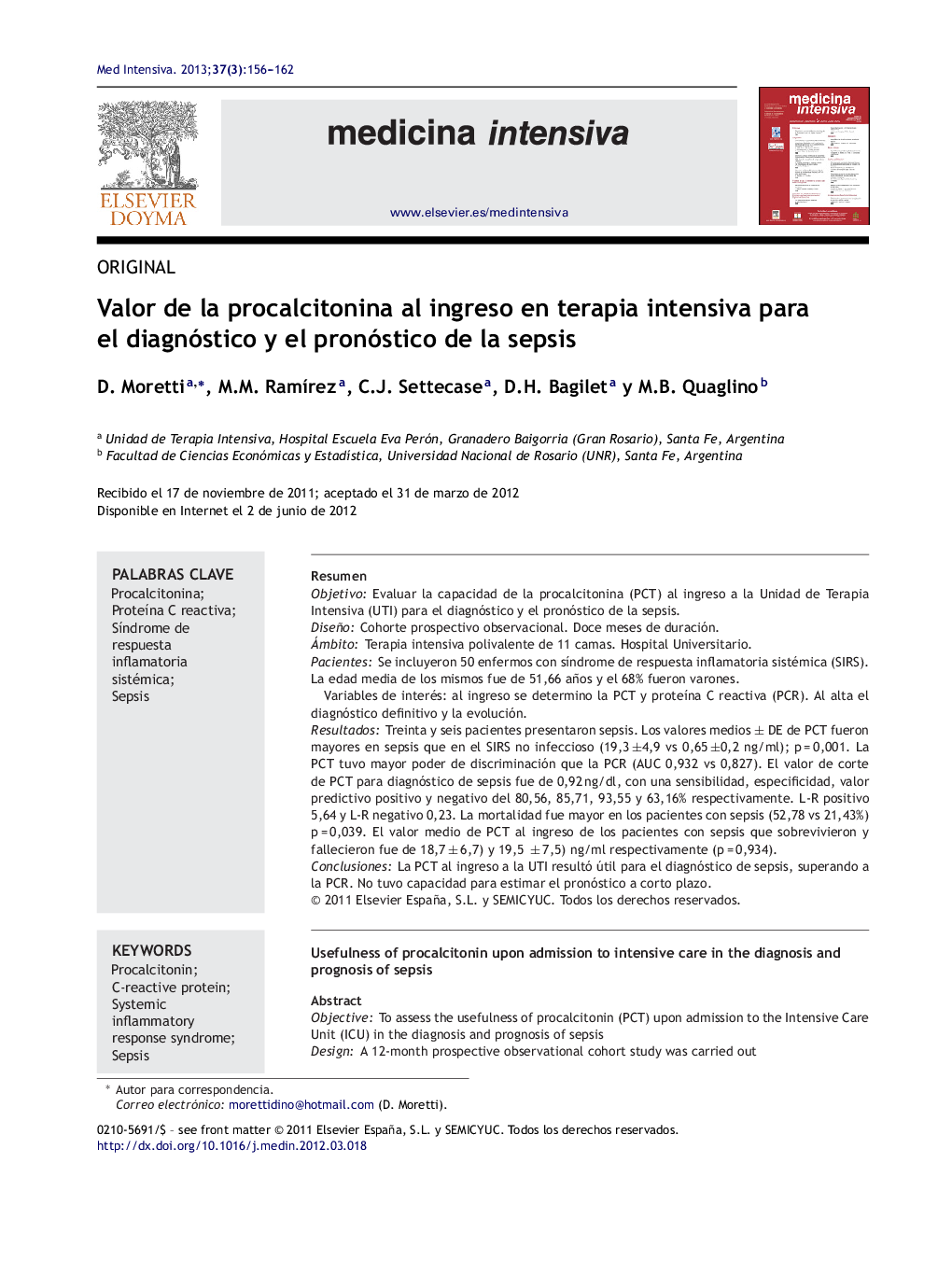| Article ID | Journal | Published Year | Pages | File Type |
|---|---|---|---|---|
| 3112694 | Medicina Intensiva | 2013 | 7 Pages |
ResumenObjetivoEvaluar la capacidad de la procalcitonina (PCT) al ingreso a la Unidad de Terapia Intensiva (UTI) para el diagnóstico y el pronóstico de la sepsis.DiseñoCohorte prospectivo observacional. Doce meses de duración.ÁmbitoTerapia intensiva polivalente de 11 camas. Hospital Universitario.PacientesSe incluyeron 50 enfermos con síndrome de respuesta inflamatoria sistémica (SIRS). La edad media de los mismos fue de 51,66 años y el 68% fueron varones.Variables de interés: al ingreso se determino la PCT y proteína C reactiva (PCR). Al alta el diagnóstico definitivo y la evolución.ResultadosTreinta y seis pacientes presentaron sepsis. Los valores medios ± DE de PCT fueron mayores en sepsis que en el SIRS no infeccioso (19,3 ±4,9 vs 0,65 ±0,2 ng/ml); p = 0,001. La PCT tuvo mayor poder de discriminación que la PCR (AUC 0,932 vs 0,827). El valor de corte de PCT para diagnóstico de sepsis fue de 0,92 ng/dl, con una sensibilidad, especificidad, valor predictivo positivo y negativo del 80,56, 85,71, 93,55 y 63,16% respectivamente. L-R positivo 5,64 y L-R negativo 0,23. La mortalidad fue mayor en los pacientes con sepsis (52,78 vs 21,43%) p = 0,039. El valor medio de PCT al ingreso de los pacientes con sepsis que sobrevivieron y fallecieron fue de 18,7 ± 6,7) y 19,5 ± 7,5) ng/ml respectivamente (p = 0,934).ConclusionesLa PCT al ingreso a la UTI resultó útil para el diagnóstico de sepsis, superando a la PCR. No tuvo capacidad para estimar el pronóstico a corto plazo.
ObjectiveTo assess the usefulness of procalcitonin (PCT) upon admission to the Intensive Care Unit (ICU) in the diagnosis and prognosis of sepsisDesignA 12-month prospective observational cohort study was carried outSettingAn 11-bed polyvalent ICU Belonging to a University hospitalPatientsFifty patients with systemic inflammatory response syndrome (SIRS) were included. The mean age of the patients was 51.66 years, and 68% of them were malesVariables of interestUpon admission, the concentration of PCT and C-reactive protein (CRP) was assessed. At discharge, the final diagnosis and outcome were reviewedResultsThirty-six patients had sepsis. Mean PCT ± SD was higher in sepsis than in non-infectious SIRS (19.3 ±4.9 vs. 0.65 ± 0.2) ng/ml) (P = .001). PCT had greater discriminating power than CRP (AUC 0.932 vs. 0.827). The cut-off value of PCT for the diagnosis of sepsis was 0.92 ng/dl, with a sensitivity of 80.56%, specificity 85.71%, positive predictive value 93.55% and negative predictive value 63.16%, LR+ 5.64 and LR- 0.23. Mortality was higher in patients with sepsis (52.78% vs. 21.43%) (P = .039). Mean PCT ± SD upon admission among survivors and deceased patients with sepsis was 18.7 ± 6.7 and 19.5 ± 7.5 ng/ml, respectively (P = .934).ConclusionsPCT upon admission to the ICU is useful for the diagnosis of sepsis, and is more effective than PCR in this respect. However, it is of no help in estimating the short-term prognosis.
